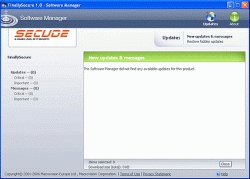Momentus 5400 FDE.2: Data Encryption On-a-Drive
Emergency Recovery
You will get this screen after POST; the login data resemble your Windows account. Should you change it or lose the password you have two recovery options, which both require the emergency recovery file that holds the master key.
Should you forget your password, you can recover the system by clicking on HelpDesk within the bootup password prompt. You need the medium that holds the emergency recovery file - a CD, a memory stick or anything else that can be accessed by the boot partition. Once the ER file has been accessed, you can capture your user to use for the next boot process. This resembles the situation after the initial boot, when FinallySecure grabs the user data after the first startup.
The second option to recover is the recovery CD, which basically works as a replacement of the boot partition on the Momentus 5400 FDE.2 drive should this partition go bad. Once the user data has been reset - again, using the ER file and the master password - you can start your Windows installation again. Be sure that you boot the recovery tool from the same mass storage controller as the one you're using for the Momentus 5400 FDE.2, or it won't work.
Updater
FinallySecure has a built-in update tool, which can be used in Windows to download and install the latest components and updates.
Some Obstacles
In addition to the limited support - Windows XP only, with Vista not yet supported - we found some other obstacles that could prove annoying. For starters, the encryption feature and software does not seem to work with all chipsets. Information about this can be found in the readme file, but it's not obvious when browsing the product features. Our first test system was an Acer Ferrari 1000 notebook based on an integrated ATI chipset, which caused the FinallySecure software to say goodbye with a runtime error. We then decided to run the tests on a system based on an Intel G33 chipset platform, which worked properly. Although we're sure that only very few Momentus 5400 FDE.2 drives will be sold in retail - I expect most of them to be found in notebook solutions from Dell and others - the limited chipset support could be an issue.
As good as the recovery solution may work, it is a Linux command line application, which you won't be able to master if you don't have extensive Linux experience or the FinallySecure manual. Leaving the user alone with this solution will indeed mean the data is secure. Again, we expect this feature to be used by administrators with significant knowledge, but it is not suitable for consumers who would like to run the Momentus 5400 FDE.2 in an effort to encrypt their data.
Though I would not call it an obstacle, the entire boot process will be noticeably longer once FinallySecure is installed and active. The first step is to authenticate yourself with the Momentus 5400 FDE.2 hard drive before you'll be granted access to Windows. If you select the secure logon option, you'll even have to press CRLT+ALT+DEL before you can log in. However, logging on to the hard drive only has to be performed during cold starts, which means after hibernation or shutdown, but not after restarts nor resuming after standby. It took us 11 seconds to get the FinallySecure login screen once the BIOS finished its POST, and another 5.5 seconds until we saw the Windows splash screen. Impatient users should be aware of this delay.
Get Tom's Hardware's best news and in-depth reviews, straight to your inbox.

Patrick Schmid was the editor-in-chief for Tom's Hardware from 2005 to 2006. He wrote numerous articles on a wide range of hardware topics, including storage, CPUs, and system builds.

